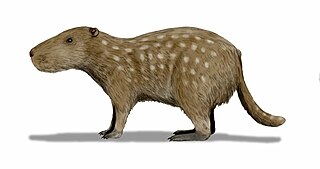Phoberomys pattersoni is an extinct rodent that lived in the ancient Orinoco River delta around 8 million years ago. It was the second-largest of the roughly seven species of its genus. Like many other rodents, Phoberomys was a herbivore with high-crowned premolars and molars.

Ponerinae is a subfamily of ants in the Poneromorph subfamilies group, with about 1,600 species in 47 extant genera, including Dinoponera gigantea - one of the world's largest species of ant. Mated workers have replaced the queen as the functional egg-layers in several species of ponerine ants. In such queenless species, the reproductive status of workers can only be determined through ovarian dissections.

Dominican amber is amber from the Dominican Republic. Resin from the extinct tree Hymenaea protera is the source of Dominican amber and probably of most amber found in the tropics.

Josephoartigasia monesi, an extinct species of South American caviomorph rodent, is the largest rodent known, and lived from about 4 to 2 million years ago during the Pliocene to early Pleistocene. The species is one of two in the genus Josephoartigasia, the other being J. magna. J. monesi is sometimes called the giant pacarana, after its closest living relative, the pacarana in the family Dinomyidae. The species may have weighed a ton, considerably larger than any living rodent.

Mourasuchus is an extinct genus of giant, aberrant caiman from the Miocene of South America. Its skull has been described as duck like, being broad, flat and very elongate, closely resembling what is seen in Stomatosuchus, an unrelated crocodylian that may also have had a large gular sac similar to those of pelicans or baleen whales. Mourasuchus, is a strange nettosuchid with an unusually long, broad snout.

Nuclearia is a nucleariid genus.

Anochetus is a genus of carnivorous ants found in the tropics and subtropics throughout the world.

Anochetus boltoni is a species of ant in the genus Anochetus. It was discovered in 2003 by B. L. Fisher in Madagascar and described by Fisher, B. L. & Smith, M. A. in 2008.

Anochetus goodmani is a species of ant in the subfamily Ponerinae.

Anochetus ambiguus is an extinct species of ant in the subfamily Ponerinae known from two possibly Miocene fossils found on Hispaniola. A. ambiguus is one of eight species in the ant genus Anochetus to have been described from fossils found in Dominican amber and is one of a number of Anochetus species found in the Greater Antillies.
Anochetus brevidentatus is an extinct species of ant in the subfamily Ponerinae known from two possibly Miocene fossils found on Hispaniola. A. ambiguus is one of eight species in the ant genus Anochetus to have been described from fossils found in Dominican amber and is one of a number of Anochetus species found in the Greater Antillies.

Anochetus conisquamis is an extinct species of ant in the subfamily Ponerinae known from one possibly Miocene fossil found on Hispaniola. A. conisquamis is one of eight species in the ant genus Anochetus to have been described from fossils found in Dominican amber and is one of a number of Anochetus species found in the Greater Antilles.

Anochetus corayi is an extinct species of ant in the subfamily Ponerinae known from one possibly Miocene fossil found on Hispaniola. A. corayi is one of eight species in the ant genus Anochetus to have been described from fossils found in Dominican amber and is one of a number of Anochetus species found in the Greater Antillies.

Anochetus dubius is an extinct species of ant in the subfamily Ponerinae known from two possibly Miocene fossils found on Hispaniola. A. dubius is one of eight species in the ant genus Anochetus to have been described from fossils found in Dominican amber and is one of a number of Anochetus species found in the Greater Antillies.

Anochetus exstinctus is an extinct species of ant in the subfamily Ponerinae known from two possibly Miocene fossils found on Hispaniola. A. exstinctus is one of eight species in the ant genus Anochetus to have been described from fossils found in Dominican amber and is one of a number of Anochetus species found in the Greater Antillies.

Anochetus intermedius is an extinct species of ant in the subfamily Ponerinae known from two possibly Miocene fossils found on Hispaniola. A. intermedius is one of eight species in the ant genus Anochetus to have been described from fossils found in Dominican amber and is one of a number of Anochetus species found in the Greater Antilles.

Anochetus lucidus is an extinct species of ant in the subfamily Ponerinae known from two possibly Miocene fossils found on Hispaniola. A. lucidus is one of eight species in the ant genus Anochetus to have been described from fossils found in Dominican amber and is one of a number of Anochetus species found in the Greater Antillies.
Pappotherium is an extinct genus of mammals from the Albian of Texas, US, known from a fossilized maxilla fragment bearing two tribosphenic molars, discovered within the Glen Rose Formation near Decatur, Wise County, Texas.

Ponerini is a tribe of Ponerinae ants with 46 genera and 6 extinct genera.
















